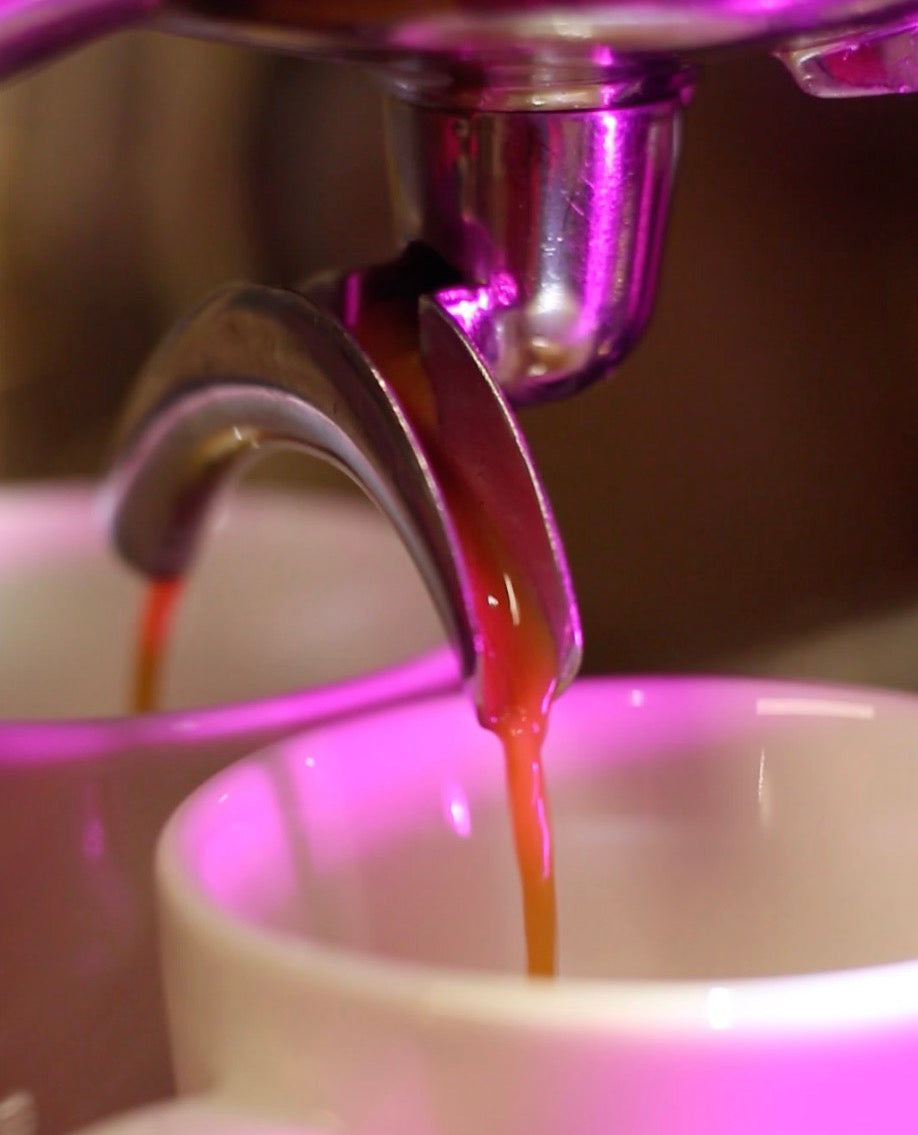Coffee Information
Carbonic maceration is a somewhat controversial process. Since its introduction to the specialty coffee zeitgeist via the infamous 2015 World Barista Championship first place finish, it has been used in various ways as a tool of pressure on producers, primarily driven by industry roasters.
However, when it is a process driven from the source, it is a very effective tool for diversifying the supply. When a producer has the opportunity, and the skill, to incorporate this type of process, they open up space in a more sophisticated market, which usually pays more for the risk.
In this case, the coffee came from the hand of Jorge Elías Rojas, producer and owner of La Roca State; whose dedication and rigor earned him third place in the 2022 Cup of Excellence competition.
This batch of Caturra went through a selective harvesting process, followed by cleaning and segregation of the ripest cherries. Then, the coffee enters a fermentation tank and the latter is injected with carbon dioxide to completely remove oxygen from the environment. After 96 hours of fermentation, the coffee was dried in cherries, as would be done in a natural process, on canopies in the shade.
The combination of extended fermentation and anaerobic conditions, together with natural drying—applied to a variety with a solid reputation, such as Caturra in Colombia—produces clear red fruit flavors, with a bright and juicy acidity, and a residual flavor close to candied orange peel.
Producer: La Roca State , Jorge Elias Rojas .
Country: Colombia.
Region: Tolima.
Altitude: 1850 mts.
Variety: Caturra.
Post-harvest process: Controlled fermentation in an anaerobic environment with carbon dioxide injection, cherry drying.
Harvest: 2022-2023.


Photographs of La Roca State.
Sensory Description
Orange candy, apricot juice, raspberry-flavored jelly powder, candied orange peel, pickled cranberry, lemon juice.
High effervescent acidity, medium round sweetness and low aromatic bitterness.
Silky body, juicy texture and persistent finish.
Import
This coffee was imported to Chile by Alto Bonito , who exchanged the last kilo they had of this green coffee for a personalized extraction workshop and manual methods ; valued at 38,000 CLP per kilo.
Roasting
When roasting this coffee, the main difficulty was finding a point where the acidity shined, but there were no signs of underdevelopment (vegetal notes, cereals, salts). In darker roasts, however, it was common to find plastic flavors. The solution was to reach a relatively fast roast, with little time after the first crack, but reaching a sufficiently high final temperature.
Toaster: Kaffelogic Nano 7
Load: 90 grams
Initial humidity: 12%, rehydrated to 16%
Total time: 6 minutes, 27 seconds.
DTR: 18.8%
Final Temperature: 219 ºC
Accumulated Temperature*: 8.7
Mass loss: 15%

*We calculate this value by dividing the area under the roasting curve by the load, ([ºC x min] / grams). We consider this value, in our roaster, to be a reasonable approximation of the development of the coffee, in a broad sense.
Water
All King Solomon coffees are cupped with water that follows the recipe below, which we recommend for the best possible results. If you prefer a simpler option, we recommend using Nomadic Waters , since that is the water we commonly use.
To get to the recipe below you need to first make a couple of mineral concentrates. We used the recipes from Barista Hustle . Our water recipe aims for the highest extraction possible, and a balance between acidity, sweetness and bitterness.
Recipe:
— 185 ppm** of Magnesium Sulfate ( MgSO₄ ); that is, 185 grams of the Hardness concentrate.
— 38 ppm** of Sodium Bicarbonate ( NaHCO₃ ), that is, 38 grams of Buffer concentrate.
— 777 grams of deionized, demineralized or distilled water.
**As an equivalent in CaCO3.
To make things simpler, we will soon be launching our own bottled water, ready to use. Stay tuned!
Preparation
In general, our coffees are designed for high extractions. We recommend fine grinds, higher temperatures, and longer ratios—for filtered, between 1:20 and 1:23; for espresso, between 1:3 and 1:5. In addition, we tend to prefer relatively low concentrations, where we find the greatest clarity in descriptors.
The idea of including recommended recipes is not to prevent you from experimenting with coffee, but to share the recipes with which we have had good results.
Manual percolation coffee makers ( conical or flat bottom, such as V60, Origami, Kalita Wave, Kono, etc.)
Dose: 10 grams.
Water: 180 grams.
Drink: 165-175 grams.
Time : 3 - 4 minutes.
Temperature: Boiling; 97ºC in Santiago.
TDS: 1.2 - 1.3%.
First discharge — saturation or bloom — 40 grams, swirl the coffee maker for 5 seconds ensuring all the coffee is wet.
Second pour of 70 grams (110) at 60 seconds. Move the coffee maker gently in circles for 2 seconds.
Final pour of 70 grams (180) just before the water level reaches the coffee. Move the coffee maker gently in circles for 2 seconds.
It is recommended to reach something close to these parameters with another coffee first. Try to make all pours from the highest possible height that does not break the flow or generate bumps on the surface of the water, in a circular motion over the coffee and maintaining a controlled flow. In addition, it is recommended to keep the water boiling between pours.
Immersion coffee makers (such as AeroPress, French Press, Hario Switch, Clever, etc.)
Dose: 10 grams.
Water: 160 grams.
Drink: 140-150 grams.
Time: 8 - 9 minutes.
Temperature: Boiling; 97ºC in Santiago
TDS: 1.3 - 1.4%
[AeroPress, standard method]
Pour the 160 grams of water over the coffee, trying to pour as quickly and from as high as possible so as not to create any bumps on the surface of the water. Stir carefully, making sure to wet all the coffee evenly.
Insert the plunger without applying pressure to create a vacuum.
At 7 1/2 minutes, with the plunger still inserted, gently move the pot in a circular motion for 5 seconds.
At 8 minutes, begin pressing the plunger very gently for 30 to 60 seconds; press all the way down.
For other immersion coffee makers, use the same proportions and start filtering after 8 minutes. For a French press, leave the filter at the level of the drink's surface, do not press all the way to the bottom and pour gently.
It is recommended to first reach something close to these parameters with another coffee, and use the finest grind with which it is still easy to press the plunger smoothly.
Espresso
Dose: 15 grams.
Water: The water you use in your espresso machine, or the recipe indicated, if you have a machine that allows it easily.
Drink: 45-50 grams.
Time: 15-20 seconds.
Pressure from pump: 6 bar
Temperature: 93-94ºC
TDS: 7 - 8%
It is recommended to reach something close to these parameters beforehand with another coffee. Let the drink cool a little before tasting. For something like a allongé , use the same parameters, but aim for a 75-90 gram drink in about 30-40 seconds. For something like a sprover , aim for 190-200 grams in about 40-60 seconds.
Zero Bypass Coffee Makers (Tricolate and Next Level Brewer)
Dose: 10 grams.
Water: 200 grams, recipe included.
Drink: 180 - 190 grams.
Time: 4-5 minutes.
Temperature: Boiling; 97ºC in Santiago
TDS: 1.3 - 1.5%
[Tricolate]
First pour —saturation or bloom— of 30 grams, move the coffee maker for 10 seconds ensuring that all the coffee is wet or stir carefully with WDT tool.
Second pour of 85 grams (115) at 30 seconds. Move the coffee maker gently in circles for 3 seconds.
Third pour of 85 grams (200) when the water level from the first pour is ~1 cm from the coffee. Move the coffee maker gently in circles for 3 seconds.
For the Next Level LVL-10, use 30 grams of coffee to 600 grams of water, with a slightly coarser grind. For other zero-bypass coffee makers, maintain the proportions but use the dosage recommended by the manufacturer. It is recommended to first get close to these parameters with another coffee. Also, it is recommended to keep the water boiling between pours.
Music
All of our coffees also come with a Spotify playlist, featuring songs we like to listen to while brewing and drinking. Generally, the songs we include in each playlist relate to some sensory aspect of coffee; but explaining exactly how they relate goes beyond words.
Listen to La Roca Carbonica on Spotify.


